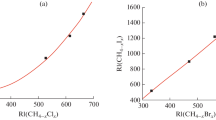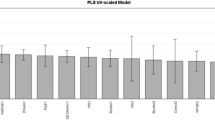Summary
Using the method of target factor analysis (TFA) described by Malinowski and Howery a computer program has been developed to study different sets of gas chromatographic retention data. Physico-chemical, topological and uniqueness parameters have been found to be basic factors to describe solute behaviour problems. Factor analytical solutions have been used to reproduce the data matrices and to make predictions based on best sets of basic factors. The mean absolute error in the reproduction step is between 1.72 retention index units (i.u.) for a relatively simple matrix consisting of retention indices of alcohols and 7.36 i.u. for a combined data matrix of alcohol, aldehyde and ketone retention indices. TFA has also been used to classify solutes based on their retention behaviour. Alkanes have been classified from cycloalkanes, alkanes from alkenes, and alcohols from aldehydes and ketones using only their retention data and a special kind of uniqueness vector.
Similar content being viewed by others
References
E. R. Malinowski, G. D. Howery, “Factor Analysis in Chemistry” John Wiley & Sons, New York, 1980.
J. A. Rijks, C. A. Cramers, Chromatographia,7, 99 (1974).
The Sadtler Standard Gas Chromatography Retention Index Library, Sadtler Research Laboratories, Philadelphia, 1985.
W. O. McReynolds, “Gas Chromatographic Retention Data”, Preston Technical Abstract Co., Niles, III., 1966.
Handbook of Tables for Organic Compound Identification, CRC Press, Boca Raton, USA, 1967.
Tables of Experimental Dipole Moments, W. H. Freeman & Co., San Francisco, 1963.
M. Gassiot-Matas, G. Fipo-Pamies, J. Chromatogr.,187, 1 (1980).
M. Randic, J. Am. Chem. Soc.,97, 6609 (1975).
A. Bondi, “Physical Properties of Molecular Crystals, Liquids and Glasses” John Wiley & Sons, New York, 1968.
M. Randic, J. Chem. Inf. Comp. Sci.,24, 164 (1984).
P. H. Weiner, C. Dack, D. G. Howery, J. Chromatogr.,69, 249 (1972).
R. Kaliszan, Chromatographia,10, 346 (1977).
J. Bermejo, G. C. Blanco, M. D. Guillen, J. Chromatogr.,351, 425 (1986).
R. Kaliszan, H.-J. Höltje, J. Chromatogr.,243, 303 (1982).
Author information
Authors and Affiliations
Rights and permissions
About this article
Cite this article
Bergman, G., Götze, H.J., Hermann, A. et al. Application of target factor analysis of gas chromatography. Reproduction, prediction and classification. Chromatographia 32, 259–264 (1991). https://doi.org/10.1007/BF02276250
Received:
Revised:
Accepted:
Issue Date:
DOI: https://doi.org/10.1007/BF02276250




